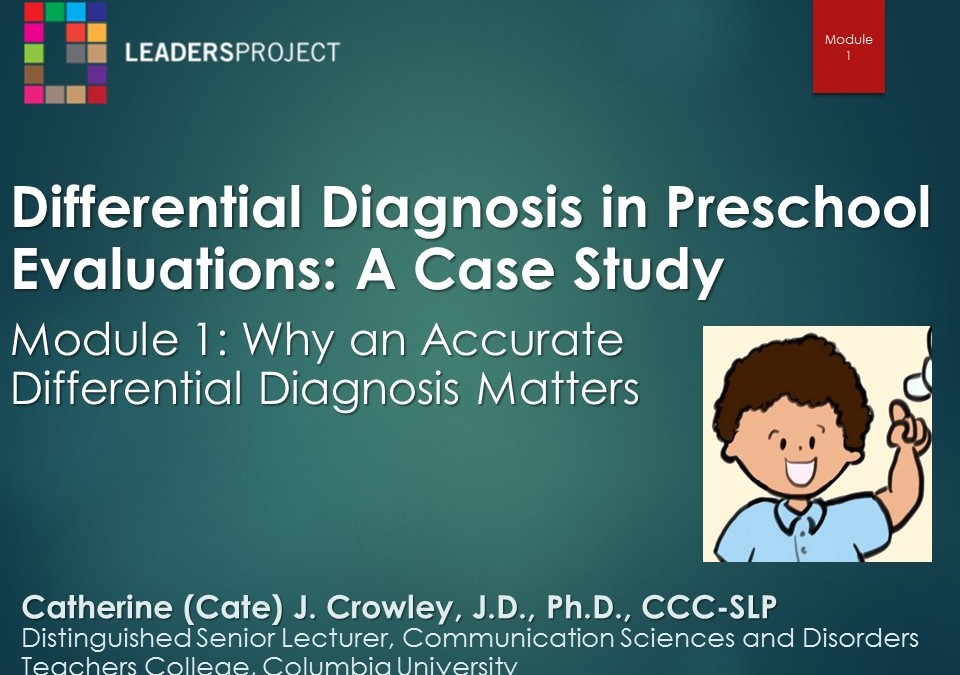Dr. Cate Crowley walks us through an appropriate evaluation of a culturally and linguistically diverse (CLD) preschooler, previously misdiagnosed. She takes us from the parent interview, to interacting with the child, writing the evaluation and even formulating appropriate IEP goals.
The purpose of this module series is to give evaluators a step-by-step approach to how to assess and evaluate a preschool-age child, based on current federal law, state regulations, ASHA guidelines, and evidence-based practice. Dr. Cate Crowley discusses the full process of using clinical judgement to come up with a differential diagnosis for a child.
Find resources used throughout this playlist here:
Current Research on Non-Speech Oral Motor Exercises
Model Eval: 2;10-English/Spanish- Verbal Apraxia
Model Eval: 2;10- Verbal Apraxia IEP Goals
Identifiers of Predominantly Spanish-Speaking Children with Language Impairment
Speech and Language Milestones

Click for Details: This language elicitation card and questions were designed as a tool to be used in assessing language for preschool and elementary school aged children. Developed by Cate Crowley and Miriam Baigorri. Illustrated by Tina Yeung.

Click for Details: This set of language elicitation cards and questions was designed as a tool to be used in assessing language for preschool and elementary school aged children. Developed by Cate Crowley and Miriam Baigorri. Illustrated by Tina Yeung.
Nonword Repetition and Child Language Impairment
Nonword Repetition Assessment Task
Find each of the modules from this playlist here:
Module 1: Why an Accurate Differential Diagnosis Matters
Module 2: Critical Questions for the Parent Interview Part 1
Module 3: Critical Questions for the Parent Interview Part 2
Module 4: Academic Language Expressive and Receptive Language
Module 5: Receptive Language Comprehension and Following Directions
Module 6: Eliciting Quality Narratives in Expressive Language
Module 7: Motor Speech, Articulation, and Speech Sound Inventory
Module 8: Dynamic Assessment: Nonword Repetition, Syllable and Sentence Repetition
Module 9: Putting it All Together in the Written Evaluation Report
Module 10: Developing Appropriate Goals for the IEP
Please find links to research mentioned in this video series here:
Bloom, L., & Lahey, M. (1978). Language Development and Language Disorders. New York, NY: John Wiley & Sons.
Christensen, M., & Hanson, M. (1981). An investigation of the efficacy of oral myofunctional therapy as a precursor to articulation therapy for pre-first grade children. Journal of Speech and Hearing Disorders, 46, 100-167. http://jshd.pubs.asha.org/article.aspx?articleid=1774894
Dale, P. (1996). Parent report assessment of language and communication. In K. Cole, P. Dale, & D. Thal (Eds.), Assessment of Communication and Language: Vol. 6, Communication and Language Intervention Series (pp. 161-182). Baltimore, MD: Brookes Publishing. http://psycnet.apa.org/psycinfo/1996-98864-008
DiDonato Brumbach, A. C., & Goffman, L. (2014). Interaction of language processing and motor skill in children with specific language impairment. Journal of Speech, Language, and Hearing Research, 57(1), 158-171. http://jslhr.pubs.asha.org/article.aspx?articleid=1802583
Dollaghan, C., & Campbell, T. F. (1998). Nonword repetition and child language impairment. Journal of Speech, Language, and Hearing Research, 41(5), 1136-1146.
Ervin-Tripp, S. (1964). An analysis of the interaction of language, topic, and listener. American Anthropologist, 66, 86-102. http://www.utexas.edu/courses/stross/ant325m_files/Readings/Ervin-Tripp%20-%20Interaction%20of%20Language%20topic%20listener.pdf
Gopnik, M. (1997) Language deficits and genetic factors. Trends in Cognitive Science, 1(1), 5-9. http://www.sciencedirect.com/science/article/pii/S136466139701005X
Harris, H. F. (1996). Elective mutism: A tutorial. Language, Speech, and Hearing Services in Schools, 27, 10-15. http://lshss.pubs.asha.org/article.aspx?articleid=1780095
Hart, B., & Risley, T. R. (2003). The early catastrophe: The 30 million word gap. American Educator, 27(1), 4-9. https://www.aft.org/sites/default/files/periodicals/TheEarlyCatastrophe.pdf
Horton-Ikard, R., & Ellis Weismer, S. (2007). A preliminary examination of vocabulary and word-learning in African-American toddlers from middle and low SES homes. American Journal of Speech-Language Pathology, 16, 381-392.
Lahey, M. (1988). Language Disorders and Language Development. New York, NY: Macmillan Publishing Company.
Lass, N. J., & Pannbacker, M. (2008). The application of evidence-based practice to nonspeech oral motor treatments. Language, Speech, and Hearing Services in Schools, 39, 408-421. http://lshss.pubs.asha.org/article.aspx?articleid=1778842
Paradis, J. (2005). Grammatical morphology in children learning English as a second language: Implications of similarities with specific language impairment. Language, Speech, and Hearing Services in Schools, 36(3), 172-187.
Paradis, J., Crago, M., Genesee, F., & Rice, M. (2003). French-English bilingual children with SLI: How do they compare with their monolingual peers? Journal of Speech, Language, and Hearing Research, 46(1), 113-127. http://jslhr.pubs.asha.org/article.aspx?articleid=1781119
Peña, E. D., & Quinn, R. (1997). Task familiarity: Effects on the test performance of Puerto Rican and African American Children. Language, Speech, and Hearing Services in Schools, 28, 323-332.
Preston, K. (2014). When a child goes silent. The ASHA Leader, 19, 34-38. http://leader.pubs.asha.org/Article.aspx?articleid=1921108
Restrepo, M. A. (1998). Identifiers of predominantly Spanish-speaking children with language impairment. Journal of Speech, Language, and Hearing Research, 41, 1398-1411.
Ruscello, D. M. (2008). Nonspeech oral motor treatment issues related to children with developmental speech sound disorders. Language, Speech, and Hearing Services in Schools, 39, 380-391. http://lshss.pubs.asha.org/article.aspx?articleid=1778840
Smit, A. B., Hand, L., Freilinger, J. J., Bernthal, J. E., & Bird, A. (1990). The Iowa Articulation Norms Project and its Nebraska replication, Journal of Speech and Hearing Disorders, 55, 779-798. http://jslhr.pubs.asha.org/article.aspx?articleid=1780453
Valenti, D.M. (2013). Sociolinguistics: Participant, Topic, Setting & Function. Available from: www.leadersproject.org
Zelaznik, H. N., & Goffman, L. (2010). Motor abilities and timing behavior in children with specific language impairment. Journal of Speech, Language, and Hearing Research, 53(2), 383-93. http://jslhr.pubs.asha.org/article.aspx?articleid=1781547


![[feed link]](/wp-content/plugins/rss-just-better/rss-cube.gif)